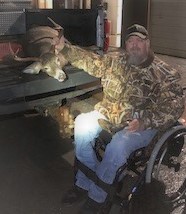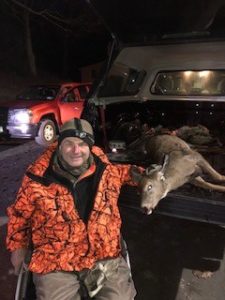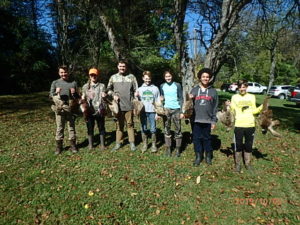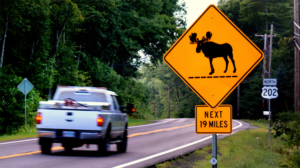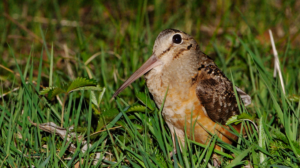Paraplegics enjoy another deer hunting season
According to Susan (Ingalls) McCarthy Wildlife Biologist and Paraplegic Deer Hunt Coordinator for the MA Division of Fisheries & Wildlife (DFW) the weather statewide was “pretty terrible” for this year’s paraplegic hunts but participants and volunteers alike still had a positive experience. Here in the Berkshires, eight hunters participated – four in the southern and four in the northern Berkshires sites.
Since 1972, MassWildlife has offered paraplegic hunters the opportunity to participate in a special 3-day hunting season. This year’s hunt was held October 31–November 2, 2019 at five sites statewide in the Northern Berkshires, the Southern Berkshires, the Quabbin Reservoir, Devens Reserve Forces Training Area in Lancaster, and Otis/Edwards Military Reservation in Falmouth.
Eighteen hunters participated in this year’s hunt and 5 deer were harvested (1 six-point buck and 4 does) for a 28% success rate. Hunters at all five sites observed deer and many were presented with shooting opportunities.
Over 35 volunteers and MassWildlife staff assisted the hunters. Staff and volunteers strategically placed hunters in safe locations where deer signs had been observed. If a hunter shot a deer, staff and volunteers assisted by tracking and retrieved the deer, field dressed, reported the harvest on site, and coordinated with a local butcher for processing.
“This is my ninth year staffing the deer hunt for paraplegic sportsmen and my second year as the coordinator of the program. Participating in this special hunt has always been an incredible honor and such an enjoyable experience,” said McCarthy, “This program could not possibly be successful without our many volunteers, MassWildlife staff, DCR staff, military personnel at both Devens RFTA and Otis/Edwards MMR, and of course our amazing hunters.”
The southern Berkshires folks hunted in the Mount Washington area and the hunt was coordinated out of the DCR Headquarters at Mount Washington State Forest. Fred Lampro and Mark Portiere once again headed up the hunt this year. The hunters were as follows: Sidney Eichstedt of Lee, Steve Gladding of Westfield, MA, Vyto Sablevicius of Norwich, MA, and Greg Baumli of New Lebanon, NY.
The Mount Washington helpers and the number of years they have served as volunteers included: Shaun Smith (46 years), Al Vincent (46), Marc Portieri (30), Greg Arienti (24), Matt Roache (14), Chuck Pickert (12), Rick Thelig (11), Tom Dean (8), Dallas Tidwell, Jim Santolin, Mike Gaffeny, and Gavin Ziegler. Vyto’s brother-in-law Paul was also a volunteer. Once again, the cook was Chuck Pickert.
The volunteers did a lot of prep work by scouting several areas and placing (donated) trail cameras to see where the best deer activity was. They analyzed the pictures to determine the best places in which to place the hunters. Volunteers transported the hunters to the locations and helped to drive the deer toward them. When a hunter shot a deer, they tracked it, field dressed it and dragged it to the vehicle.
And what can I write about Chuck Pickert, his wife Beverly and Tricia Volmer. For the last 12 years in a row, Chuck brought his trailer-mounted smoker/grill and they cooked breakfasts and lunches for the three days. A lot of friends who own restaurants and businesses donate food, charcoal, condiments, etc., every year (See donor list below).
On Thursday, the lunch menu was Irish Stew prepared by Tricia Vollmer and Chuck’s Grandma’s Poor Man Stew with corn bread. (Good meal on a cold, rainy day). On Friday it was roast beef served with mashed potatoes, etc., and on Saturday it was brined pork loin cut thin like minute steak. Unfortunately, I couldn’t make the event this year, but you better believe I already have my calendar marked for next year’s hunt which is October 29–31, 2020.
So how did the hunt go this year in the Southern Berkshires? Well, Sid Eichstedt shot a 6- point 145lb buck and Steve Gladen got a 110lb doe. Vyto Sablevicius and Greg Baumli both saw deer but didn’t shoot any.
Southern Berkshire Paraplegic Hunt Donors included: Roma Pizza, Pop’s Diner, C A Lindell, Jay Lawn Care all from North Canaan, CT, Cranes Outdoor Power Equipment and Davis Tires of Canaan, CT , Wood Creek Bar & Grill from Norfolk, CT, Mill River General Store, Mill River, MA, JTC & Sons, Greg S. Massini Bus Co. and Massini Bus Co. from Sheffield and Fiddleheads Grill in Great Barrington.
Rick French coordinates the hunt with the volunteers and hunters at the Northern Berkshires site. The four hunters at the Northern Berkshires site were: Dale Bailey of Clarksburg, Shawn Mei of Baldwinville, MA, Dave Alderman of Petersburg, NY and Kevin Hollister (Greenfield area). Volunteers included French, Tony Mei, Robert Mei, Stacy Sylvester, J. Sylvester, Joe Benoni and Ben Pike. With permission, they hunted private properties in the Williamstown area. No deer were taken up there but nearly everyone saw deer.
DFW Western District biologist Nate Buckhout along with DFW staff Jacob Morris-Siegel, Derek McDermott and Ray Bressette were on hand at the sites to help out and check in the deer.
For more information about the paraplegic hunt, contact MassWildlife Field Headquarters at (508) 389-6300.
Lastly, thanks to you eighteen Massachusetts hunters for staying in the game in spite of the lousy hands that you have been dealt in this life. You are an inspiration to all of us, especially those who also are struggling with physical and emotional problems. And kudos to the volunteers and everyone involved with this program for your time and energy in helping them enjoy a couple of days in the outdoors. We could use more of that selfless, “caring for our fellow man” attitude in these turbulent times.
New Pheasant Stocking Map
At the last meeting of the Berkshire County League of Sportsmen, DFW Western District Supervisor Andrew Madden announced that the Division is working on a new map showing pheasant stocked areas across Massachusetts. The map is still in development, and your feedback this season will help them finalize the features and design. The map shows general stocking locations and stocking frequency, provides directions to parking and special notes about stocked properties. Check it out on https://www.mass.gov/info-details/find-a-pheasant-stocked-area. Feedback is welcome
New England Outdoor Writer Association Board Member Lyon killed in boating accident
NEOWA Board Member Harold “Hal” Lyon, 84, of Meredith, NH, was killed when his and his close personal friend’s boats collided on Lake Winnipesaukee on the evening of November 9. His friend, Jim Hanson, who piloted the other boat died also. Jim’s wife Carmel suffered serious, but non-life- threatening injuries. She was taken to Lakes Region General Hospital in Laconia, NH. Hal was in the boat alone.
Both boats were making a turn round Bear Island (the second-largest island in Lake Winnipesaukee) at the same moment, shortly after 6:00 pm when they collided. Friends said that it wasn’t a windy night, but it was cold and dark.
Jim and Hal were close friends and they often hunted for deer together. Friends said that the very reason that Hal was away from his home was so that he could scout for hunting spots to go with Jim once the season opened.
Lyon, was the author of seven books including the award-winning “Angling in the Smile of the Great Spirit” a guide on big glacial lake fishing based upon his fishing experiences on Lake “Winni”. Incidentally, the Native American name given to the lake means either “smile of the Great Spirit” or “beautiful water in a high place.”
I first met Hal at the Springfield Sportsmen’s Show shortly after he wrote that book in 2008. He was manning a booth there and when he spotted my NEOWA ID tag as I walked by, he stopped me and started up a conversation. He was a pleasant, friendly person, someone who you would instantly like. We had a lengthy chat about outdoor writing and when it came time for me to move on to other exhibitors, Hal gave me a numbered, autographed, limited edition of his excellent book. We stayed in touch off and on over the years and the last time we chatted was at a NEOWA function on Post Pond in Lyme, NH a few years ago.
Isn’t it ironic that his final moments were spent boating on the lake he loved so much in front of the island where he and his wife Karen were married in 2009.
I think NEOWA Board Member Joe Judd put it best. “His writings were legendary. Now, he is a legend lost … but will live on through his writings forever.”
Large black bear taken in Sheffield. Is it a state record?
It was a pleasant afternoon on November 5 and after work, Mike DiGiovanni of Sheffield decided to go hunting for bear on a local farmland. He hunted out of a tree stand with a crossbow. (Due to a permanent disability, he had permit to hunt with a crossbow). After a while he saw a deer (doe) in the nearby field acting oddly and then ran off. Then Mike saw why. A bear approached the field, hugged the edge of it and headed right toward him. He held off his shot until the bear was about 10 yards away and let the bolt fly. The first bolt hit him high in the shoulder and the second shot was a lung shot and down he went.
He knew it was a decent sized boar, perhaps around 300 lbs, but it wasn’t until he climbed down from the tree stand and approached it that he realized how big it was. Mike described himself as being “dumbfounded”. Then came the realization of what to do now. He took a picture on his cell phone and sent it to his wife Molly saying, “I’m going to be home a little bit later than expected”. 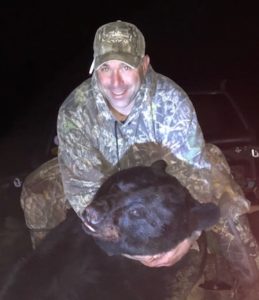
Then, he called a couple friends while Molly called his brother-in-law for help. Mike also reached out to the farmer for an extra set of hands. The farmer had a 4-wheeler to help him get it out of the woods and into the field. Dragging a bear of this size is no small feat and the more help he could get, the better. It took 6 guys, the farmer’s 4- wheeler and a pick-up truck. Thank goodness it was only 10 feet from the field, said Mike, because if it was deeper in the woods, there was no way to get him out…..not without equipment. With permission from the farmer, they were able to drive a truck into the field to get to him.
Can you imagine what it was like lifting that bear onto Mike’s truck?
After getting the bear out of there, they weighed it at a gravel bed truck scale and the weight they came up with was 540 lbs. Roughly a day and a half after, they got it to the DFW Headquarters in Dalton and it weighed 535 lbs. on those scales. Perhaps the day delay could have made the 5 lbs. difference (drying out). Anyway, the official weight stands at 535 lbs. Mike has been bear hunting for 12 to 14 years and never got a bear this large.
One of the biologists at the DFW headquarters guessed it weighed around 640 to 650 lbs. live weight and estimated the age as being between 7 and 12 years old, but it could be older. They can’t know until a tooth is sent to the DFW labs for analysis.
Is it a state record? Not sure. Massachusetts doesn’t keep official state bear records; however, they do maintain a database of the largest bears on record. I am not aware if there has ever been a larger bear checked in with DFW so it is quite possible that it is the record. If the DFW wants to establish a state record for black bears, may I suggest that they start with this one.
Mike said that he lost some of the meat due to the weather, but will salvage as much as he can to eat. “It’s quite good”, he said, “if I didn’t like the meat, I would not shoot a bear.”
He is going to get a whole rug mount done by Kevins’s Taxidermy of Middlebury, CT. Incidentally, the taxidermist measured the hide from nose to the tail at 86 inches and girth at 65 inches. The unofficial Green Score skull came in at 21 ¼ inches. To make the Pope & Young record book, it has to be 18 inches; however, cross bow kills are not recognized.
The farmer was ecstatic over getting rid of that bear. Not only because he kept destroying his crops, but also once a week the boar was flipping dumpsters over on his property.
Mike met a couple of neighbors who live on the same street and they were very grateful that that bear is gone. They were intimidated by the size of it. Bears are opportunistic, wherever the food is, that is where they are going to be, whether it is at your house or somewhere in the woods. They are going to eat whatever they want and you are not going to stop them, said Mike. He has heard stories of bears taking livestock, goats, pigs and all sorts of animals (not to mention the deer fawns).
Mike was adamant that the names of the helpers be included in this column for without them, he could not have gotten the boar out of the woods. (They were: Jameason Russin, Tony Bleau, Kolby Bleau, Dave Ullrich and the farm owner Bob)
That feat was” something I’ll never forget”, said Mike.
A Patriotic Turkey Shoot
The Murphy-Leary American Post 298 and Adams-Budz VFW Post 8183 of Housatonic will be jointly sponsoring a Turkey Shoot at the Great Barrington Fish and Game Association Club, 338 Long Pond Road, Great Barrington on December 1 starting at 12:00 noon. The purpose of this event is to raise funds to help the organizations foster strong national security, provide help for disabled and needy veterans and their families and promote Americanism by educating our communities in patriotism.
Also, they sponsor and provide scholarships to civic programs such as the Boys/Girls State Program, Student Trooper Program and to local students. In addition, their fund-raising initiatives also allow them to offer academic and vocational scholarships to selected graduates from local High Schools.
The turkey shoot is billed as a great opportunity to come out and compete for a turkey, pork, steak, beef, or maybe a money prize as well as enjoy a barbecued hamburger, hot dog, fries, and refreshments. You don’t even have to shoot to win a prize. There are many people that will be there who will shoot for you.
You are invited to come out and have some fun with family and friends in one of the most picturesque locations in the Berkshires. In addition to having some old-time outdoor fun, you will be helping our Housatonic American Legion and VFW to raise money so that they may give back to the youth in our community.
MassWildlife’s Habitat Management Grant Program
Thirteen municipalities, conservation organizations, and private landowners were recently awarded a total of $341,396 for habitat management projects to improve habitat for rare or declining populations of wildlife. The grants will fund 13 wildlife habitat improvement projects totaling 698 acres in 14 communities across the state.
In its fifth year, MassWildlife’s Habitat Management Grant Program provides financial assistance to private and municipal landowners of conserved lands to improve and manage habitat for wildlife deemed in greatest conservation need and certain game species. The projects are also designed to complement ongoing habitat management efforts on state lands and expand opportunities for hunting, fishing, wildlife viewing, and other outdoor recreation.
“Fish and wildlife habitat management for both rare and common species and to enhance wildlife-related recreation opportunities is a top priority for MassWildlife,” said Dr. Mark Tisa, Director of the DFW. “Because 80% of Massachusetts is in private ownership, working with committed municipal and private landowners is a no-brainer. These grants help protect everyone’s investment in wildlife, habitat, and the enjoyment of outdoor activities such as fishing, hunting, or watching wildlife.”
Congratulations to the following local recipients of the 2019 MassWildlife Habitat Management Grants:
• Great Barrington: The Nature Conservancy was awarded $28,576 to create and improve old field and shrubland habitats at the Schenob Brook Preserve.
• Lenox: The Town of Lenox was awarded $26,810 to remove the invasive hardy kiwi plant at Kennedy Park and Mass Audubon’s Pleasant Valley Wildlife Sanctuary.
• South Lee: South Lee Associates was awarded $13,655 for efforts to control invasive species on Housatonic River properties.
It was a good year for DFW Land Acquisitions
According to a report made by DFW Western District Supervisor Andrew Madden and Western District Fish & Wildlife Board Member Stephen Sears at the October Meeting of the Berkshire County League of Sportsmen, fiscal Year 2019 (July 2018-June 2019) was another good year for the MassWildlife/Department of Fish and Game Land Protection Program.
Statewide they protected more than 2,400 acres. They completed 15 projects in the Western District alone, accounting for 1,078 acres, which is almost half of the statewide total. The annual budget for land acquisition is approximately $5.5 million.
They both highly complimented DFW Western District Land Agent Peter Milanesi for the superb job that he does every year. The list of the Western District projects is as follows:
Town Acres Description
Otis 29 Abuts Long Mountain WMA on Stebbins Road.
Plainfield 1.57 Small Inholding at Swift River WMA
Windsor 18.4 Along the East Branch of the Westfield
Dalton 100 Abuts the Chalet WMA on three sides.
Sheffield 70 Guilder Hollow Road. Abuts Dolomite Ledges WMA
Chester 100 Builds on the Western side of Fox Den WMA
Worthington 13 Improves access to Fox Den WMA.
Middlefield 90 Abuts the Fox Den WMA. Protects upper portion of the Westfield watershed
Chester 55 Part of the Fox Den WMA.
West Stockbridge 26 Extensive Frontage along the Williams River
West Stockbridge 48 Wetlands along Williams River. Part of Maple Hill WMA
Cummington 86 Stage Road. Part of the Cummington WMA
Worthington 315 Part of Fox Den WMA along the Middle Branch of the Westfield River
Chester 75 Abuts the JJ Kelly WMA.
Worthington 51 Provides access to Fox Den WMA from the East
Do those land acquisitions make you happy? Well wait until you get out and enjoy them.
I hope you read the article in the October 21, 2019 issue of the Berkshire Eagle entitled “Study: Want to be happier? GET OUTDOORS”, written by Christopher Ingraham of the Washington Post. According to scientific studies, people who got in two to three hours in nature were about 20% more likely to report high overall satisfaction with their lives than those who spent no time outdoors at all. They were 60% more likely to report being in good health than their cooped-in counterparts.
So, what are you waiting for? Check out these new acquisitions!
2019 Youth Deer Hunt Day results
On September 28, 950 young adults participated in this year’s Youth Deer Hunt Day. The statewide preliminary harvest total was 77 deer reported through the online MassFishHunt system.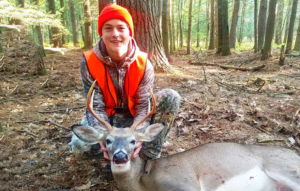
MassWildlife created the Youth Deer Hunt Day to allow young hunters to hunt deer with their own permit. The hunt occurs on a special one-day season before the state’s annual deer hunting seasons. Shotgun deer season regulations apply during the hunt. Licensed hunters who hunt other animals on this date must follow special restrictions.
Fifth Annual Berkshire Natural History Conference
Next Saturday, at the Clark Art Institute in Williamstown, Williams College will host the 5th Annual Berkshire Natural History Conference. It will run from 9:00 AM to 4:00 PM. You are invited to celebrate the incredible diversity of Berkshire County.
The Conference brings together residents and visitors to celebrate the remarkable biological diversity of Berkshire County and the efforts to preserve, restore, and learn more about species, landscapes, and the myriad interactions among all of them. An impressive list of speakers, exhibitors, and displays will cover such wide-ranging topics as historic naturalists, native brook trout, unknown organisms, and local forests.
Birds, Bogs, Little Snakes, Trout, and Slime Mold Highlight This Year’s Conference
• Botanists/historians Maida Goodwin and Allison Bell retracing the steps of the remarkable, prolific, (and somewhat erratic) late 19th century naturalist Grace Greylock Niles.
• Evolutionary biology student Jenks Hehmeyer introduces the world of incredible organisms, including the Berkshires Giant Amoeba Slime Mold.
• Author Lauren Stephens illuminating Thoreau’s decision to spend the night atop Mt. Greylock.
• Dr. Ron Bassar detailing the plight of native brook trout in light of the Climate crisis.
• Biologist, Pete Hazelton will introduce MassWildlife’s new Citizen Science initiative – the use of the cell phone app, iNaturalist, to record everything on state Wildlife Management Areas.
• Other speakers introduce the incredible density of little snakes, local efforts to restore Cliff Swallows, how the new technology, Lidar, can tell a great story, and more. Ending the day is Williams College ecologist Hank Art on the changing landscape of Western New England.
You can also check out a wide array of displays by more than a dozen local and regional natural history organizations. Purchase new and historic books and join in a Silent Auction that helps support student attendees. A Natural History quiz, where participants can test their knowledge of the Taconic/Berkshire environment, is ever popular.
It is sponsored by the Hoffmann Bird Club, BCC, MCLA, Green Berkshires, BEAT, Mass Audubon’s Berkshire Sanctuaries, Hoosic River Watershed and others.
Pre-registration is required ($25 per person; $15 per students) at: www.berkshirecc.edu/bnhc. Contact Tom Tyning for details at ttyning@berkshirecc.edu
Community Conversation: Love/Hate Relationship with Mother Nature?
This Thursday evening beginning at 7:00 pm, the Lenox Land Trust will hold its Annual Meeting at the Lenox Community Center, 65 Walker Street, Lenox. They are featuring two noted local environmentalists to help homeowners understand their own properties as part of larger landscapes and habitat.
Fighting the Good Fight – Presenter Jess Toro, of Native Habitat Restoration, will offer advice and guidance on identifying and controlling those pesky, persistent Invasive Plants in our yards and neighborhoods: knotweed, bittersweet, and barberry, among the most common of the dirty dozen species.
Where the Wild Things Are– Tom Tyning, Professor of Environmental Science at Berkshire Community College, literally “wrote the book” (A Guide to Amphibians and Reptiles), highlighting the indispensable role of Vernal Pools to biodiversity. Discover and protect the Vernal Pools in your neighborhoods and woods – they’re an essential habitat for the life cycles of many species, including the protected Spotted and Jefferson Salamanders, and an incredible landscape feature – half land, half water.
(In 2017, the Berkshire County League of Sportsmen awarded Tom its Lifetime Achievement Award for his work in this area).
The program is open to the public — to any homeowner or property-owner in Lenox or elsewhere! And dessert is on them!
Help needed in planting trees and shrubs along the Housatonic riverbank
In Great Barrington, the Housatonic River access on Division Street has been improved and a new parking lot installed thanks to a great partnership with the property owners, Berkshire Natural Resources Council (BNRC) and funding from the Great Barrington Community Preservation Council.
The area was heavily infested with invasive plants which have been treated by Native Habitat Restoration. Now it’s time to plant.
On Tuesday, November 12 from 1:30 to 4:00 pm (Rain Date/Extra Date is November 20) you are invited to help plant native trees and shrubs along the riverbank. The Housatonic Valley Association will supply the tools, but if you have a favorite digging implement, bring it along.
The event is in partnership with BNRC.
If you think you can help, contact Alison Dixon at 413-298-7024 or adixon@hvatoday.org
Directions: Please note, the bridge on Division Street is closed so the access and parking area can only be accessed from Rte.183.
Dam Removals in Massachusetts
The Department of Environmental Restoration (DER) is presenting a six-part film series entitled River Run – A Story of Dam Removal in Massachusetts. It was created in partnership with UMASS Amherst’s Science Media Collaborative. Each short video highlights the efforts of DER and partners to advance river restoration projects across the Commonwealth. These films highlight the benefits, challenges, and local perspectives of dam removal across Massachusetts. One film addresses the Tel-Electric Dam on Mill Street in Pittsfield.
To see the films, click onto:
https://www.mass.gov/info-details/river-run-a-story-of-dam-removal-in-massachusetts.
Veteran’s Day
What are you going to do on Veteran’s Day? It is a day off from work/school so maybe you will watch a parade. Will you visit some veterans in nursing homes or assisted living facilities? They would love to see you.
Perhaps you’ll go hunting, preferring to spend some quiet time in a tree stand or a duck blind or just taking a break and sitting on a stump near a stone wall. Whatever you do, you might want to take a moment to remember and thank our living and deceased veterans for their service to our country.
Beware of the Eastern Equine Encephalitis (EEE)
MassWildlife warns us that EEE is a very rare but serious disease caused by a virus that can affect people of all ages. EEE is spread to humans through the bite of a mosquito infected with the virus. EEE can cause severe illness and possibly lead to death in any age group; however, people under age 15 and over 50 are at particular risk. EEE does not occur every year, but based on mosquito sampling, a high risk of occurrence of human cases currently exists in areas of Massachusetts.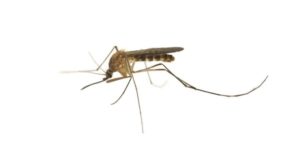
Tips for Hunters
The greatest risk that hunters face from EEE is exposure to mosquitoes, not handling or consuming game. Hunters can minimize their risk of mosquito bites by taking the following precautions:
• Wear an effective mosquito repellent with DEET, permethrin, picaridin, or oil of lemon eucalyptus while outdoors. Always follow the manufacturer’s directions for use.
• Limit exposed skin by wearing long sleeves and pants.
• Stay indoors between dusk and dawn when mosquitoes are most active.
While many species of animals, including deer and birds, can become infected with EEE, there is no evidence that people become sick from eating or handling game animals. However, hunters can minimize risk from wildlife diseases by taking the following standard precautions:
• Avoid handling or consuming wild animals that appear sick or those found dead.
• Wear gloves and safety glasses when handling, field dressing, and processing game.
• Cook game meat thoroughly to an internal temperature of 165°F to kill pathogens.
• Use caution and minimize contact with the brain or spinal tissues.
• Handle knives carefully to prevent accidental cuts.
• Wash hands thoroughly with soap and warm water after handling carcasses and before and after handling meat.
• Thoroughly sanitize all tools and work surfaces used during processing with a bleach solution (1 tablespoon of bleach to 1 gallon of water). Consider keeping a separate set of knives used only for butchering game.
Hunters or citizens observing wildlife that are behaving abnormally or appear sick should contact the closest MassWildlife office during business hours.
Hunting with Dogs
Dogs can become infected with EEE by the bite of an infected mosquito, however dogs rarely become ill from the virus. If you hunt with a dog, you can take additional precautions:
Apply mosquito repellents that are approved for veterinary use on your dog. Mosquito repellents recommended for humans are not approved for veterinary use. Consult with your veterinarian for advice about safe mosquito repellents for your dog. Read the product label before using and follow all instructions carefully.
While the risk of EEE transmission to dogs from eating or otherwise coming into contact with infected birds or mammals is considered low, consider limiting your dog’s contact with game, especially the brain and spinal tissue.
For questions about your dog’s health, contact your veterinarian.
Lee Sportsmen’s Association Youth Pheasant Hunt
Congratulations to the Lee Sportsmen’s Association (LSA) and especially John Polastri for putting on a very successful Youth Pheasant Hunt which was held on Saturday, October 5.
All youths participating harvested at least one bird, with the majority of the eight youths harvesting two birds. They used dogs owned by the following dog owners: George Haddad, Dick Salice, Dave Morris, Doug Frank and Bob Gaj. Helpers in the field were Shawn Sullivan, Mike Kelly, Jeff Leprevost and Jim Finnegan.
According to club member Ron Salice, it was a great day with the youth having the opportunity to intermingle with EPO Officer Phil Smits for most of the hunt and afterword’s at the club for lunch and cleaning of the birds. The cooks were George Brooks and Shawn Sullivan
GOAL Education and Training event
Keeping with the LSA, they will be sponsoring a GOAL (Gun Owner’s Action League) education and training event entitled MA Gun Laws for Citizens on Thursday evening, November 14 at 6:00 pm at its clubhouse at 565 Fairview Street, Lee.
Massachusetts is well known for fragmented and convoluted gun laws. This presentation will help to separate fact from fiction and provide guests with a basic understanding of MA gun law regarding the possession, transportation and storage of guns in this State. Additional topics include MA assault weapons laws, the approved roster and, the buying and selling of guns.
This class is presented by Jon Green the Director of Education and Training for GOAL.
The event is free and open to the public, but attendees might consider joining GOAL or making an in-kind donation. Please note: Seating for this event is limited, so contact Shawn Sullivan at ssullee@icloud.com if you plan to attend or require more information.
New England Outdoor Writers Association’s Outdoor Writing Contest
The NEOWA is pleased to announce the 2020 Youth Outdoor Writing Contest and the rules for the 2020 contest are as follows:
1. The contest is open to anyone in grades 6-12. This includes students from schools, outdoor organizations/publications, youth members of rod & gun clubs, Scouts, and other youth organizations in New England. All entries must be submitted to the appropriate State Chairperson.
2. Submissions from entrants in grades 6-8 will be entered in the Junior Division; submissions from entrants in grades 9-12 will be entered in the Senior Division. Junior and Senior State Winners chosen by state judges will each receive a $125 cash prize from the NEOWA. The winners from each state will be judged by a New England panel of judges for a New England Regional award. New England Regional winners from the Junior and Senior levels will each receive an additional $150, bringing their total award to $275 each. Winning works will be published in the Northwoods Sporting Journal, The Maine Sportsman, and possibly state wildlife magazines.
Note: If we have a local winner, I would be happy to include the work here in this column.
3. Entries must be non-fiction and focus on outdoor-oriented stories, which add to the knowledge and enjoyment of nature and natural resources. Entry topics may include: fishing, boating, archery, shooting, hunting, trapping, field trials, sporting dogs, camping, woodcraft, skin diving, scuba diving, hiking, rock climbing, cross-country skiing, snowshoeing, wildlife watching, natural history, conservation, ecology, and similar activities that relate to outdoor recreation, natural resources and nature.
4. Entries may not exceed 500 words. Entries must be edited by the young writer, without assistance from adults. School students and youth organization members may submit work that may have been part of an assignment within school or youth program curriculum. Adult teachers or leaders may NOT assist in editing of these submissions.
Young writers should include a title for their work, and submit their entry to the State Chair, either embedded in an email or as an attachment. Youth may submit only one entry each year.
5. The deadline for submitting contest entries is February 15, 2020. Entries must include name, grade, postal mailing address, phone, and e-mail. Entries that do not meet these or other contest rules may be disqualified.
6. NEOWA will notify the State and New England winners, and if applicable their schools/organizations. NEOWA reserves the right to publish any work submitted. However, students submitting work also retain the right to publish their entries.
7. Rules are subject to changes from year to year. For questions or to submit a contest entry, please contact your NEOWA state chairperson, or the New England Chairperson by e-mail for more information:
8. Additional Information: Organizations or schools are encouraged to conduct school or organization-wide, pre-contests in order to encourage students to enter the NEOWA state-wide contests. Each school/organization can acknowledge their own winners at an award assembly, meeting, or other recognition program, whether or not they are state winners.
Also, other youth organizations or entities such as rod & gun clubs, outdoor publications, scouting organizations, or publications can hold their own contests to promote the NEOWA writing contest among their members encouraging them to submit their writing to the NEOWA State Chairpersons to be judged at the state level. In Massachusetts, the State Chair is Marion Larson, marion46@verizon.net and the Co-Chair is Barnet Sherman, bs8082@gmail.com.
Get to work guys and gals, make us proud.
Public Hearings coming up regarding Coyote and Wanton Waste regulations
Two upcoming public hearings will be conducted by MassWildlife on proposed new regulations, summarized as follows:
It is proposing the prohibition of contests for the capture, take or waste of certain predator or furbearing animals, and a new section that would prohibit the “waste” of certain game animals and birds.
MassWildlife is also proposing an amendment to existing regulations that would change the time for checking harvested fox and coyote from four days from the end of the season to within forty-eight hours of harvest.
The first public hearing will be held this Tuesday at 7:00 pm, at the Lenox Town Hall, 6 Walker Street, Lenox. The second public hearing will be held on Tuesday, October 29, at 7:00 pm, at the Field Headquarters, Richard Cronin Building, 1 Rabbit Hill Road, off North Drive, Westborough.
The draft of MassWildlife regulations, as well a related summary and other explanatory information, are available for review by the public at https://www.mass.gov/servicedetails/fisheries-and-wildlife-board-public-hearings.
There is a 2-week public comment period after the public hearings. The Fish & Wildlife Board will then review the comments at a future meeting and decide on a path forward.
Preliminary bear harvest report
In his October report to the Berkshire County League of Sportsmen, DFW Western District Supervisor Andrew Madden reported that during the September bear hunting season, licensed bear hunters reported a harvest of 137 bears; 55 reported as female, 82 as male.
This is down slightly from the 151 and 145 taken during the September season in 2017 and 2018. He felt that this may be partly due to the abundance of natural foods available this fall.
The Second Season opens on November 4 and runs through November 23.
Hopefully, if you harvested a black bear this season, you submitted a tooth and hair sample to MassWildlife. Teeth are used to find out a bear’s age, and hairs are used to study bear genetics. If you haven’t submitted the samples and wish to, MassWildlife has a video guide on how to properly extract the tooth and it is suggested that you watch it before attempting it yourself. There are also instructions as to which hairs should be sent.
They ask that you provide them with precise locations where the bears were harvested.
If you have any questions, contact MassWildilfe Black Bear & Furbearer Biologist, Dave Wattles at (508) 389-6359 or dave.wattles@mass.gov
You will receive a letter in June or July with the age of your bear.
Wild Turkey Hunting
The fall hunting season for wild turkey opens tomorrow and runs until November 2. As you may be aware, the Fisheries & Wildlife Board recently approved turkey hunting changes affecting bag limits, fall season dates, shot size, and the Youth Hunt.
NOTE: Regulation changes will NOT be effective until 2020. There are no changes to turkey hunting regulations in 2019.
Other hunting seasons open
On October 12, the hunting season for ducks and geese opened up here in the Berkshires. Be sure to familiarize yourselves with all of the regulations. You can find them at the MassWildlife web site by clicking onto Waterfowl.
There are new bag limits this year: The Mallard daily bag limit has been decreased to 2 birds (only 1 female), the Regular Goose daily bag limit for the Berkshire Zone has been decreased to 2 birds, and the Northern Pintail daily bag limit has been increased to 2 birds.
Yesterday, the hunting seasons opened for cottontail rabbits, snowshoe hare, pheasants and ruffed grouse.
Every year, MassWildlife stocks about 40,000 ring-necked pheasants statewide. These birds are stocked on public and private lands that are open to hunting. The Western District should be receiving about 10,000 of them for stocking. For a listing of local areas stocked and the frequency of stocking, click onto: https://www.mass.gov/service-details/pheasant-stocked-areas.
Incidentally, in Vermont, biologists hope a multistate research program will help them determine if West Nile virus could be responsible for a decline in the population of ruffed grouse across the Northeast and other parts of the country. Vermont is taking part in the project to determine the distribution, prevalence and potential effect of the virus on the bird and are asking hunters to help collect blood and feather samples from the birds they take this season and submit them to the state so they can be tested for the mosquito-borne illness.
The populations of the birds have been declining in several locations and biologists suspect West Nile, an illness that can also infect people, could be at least partially responsible.
Stresses are adding up because of a loss of suitable habitat, said Benjamin Jones, president and CEO of the Ruffed Grouse Society & American Woodcock Society. The Southeastern Cooperative Wildlife Disease Study is working with state biologists and veterinarians from the Great Lakes, Mid-Atlantic, Southeast and Northeast to test blood samples from hunter-harvested ruffed grouse.
Its goal is to estimate West Nile infection rates in wild grouse. Once finalized, the data will be shared with the participating states.
Coyote hunting season opened on October 13. NOTE: The current, existing coyote regulations (as described in the 2019 abstracts) ARE STILL IN EFFECT. There are no changes to coyote hunting regulations in 2019.
Tomorrow the Archery Hunting Season opens in Zones 1 – 9. Don’t forget, an Archery Stamp is required.
Hunters would be wise to refamiliarize themselves with the various regulations which affect these hunting seasons.
Here’s wishing you an enjoyable and safe hunting season!
Be alert for moose and deer
Fall is moose breeding season, which means the animals are more active, and they sometimes follow waterways into urban areas, according to wildlife officials. Whether in a car or on foot, it’s best to keep your distance — moose are big, and they can get aggressive if they feel threatened.
Last month, two moose made it into Worcester, MA the same day but only one made it out alive. One was a 600 lbs moose roaming around St. John’s Cemetery which the Worcester police and DFW personnel tranquilized and relocated to a rural area.
But later that day, a second moose wasn’t so lucky. A young bull, thought to be about 3-1/2 years old was hit by two cars on Stafford Street, Worcester. The moose suffered compound fractures in its legs and had to be euthanized.
MassWildlife reminds motorists to be mindful of increased deer and moose activity, especially during early morning and evening hours. Moose, found in central and western parts of Massachusetts, breed in September and October. White-tailed deer breed from late October to early December.
To protect yourself, your vehicle and the deer and moose from physical damage, please slow it down a bit while driving through dark and remote areas at night.
Wildlife observations
If you are an archery deer hunter or a game bird hunter, consider keeping a hunting log on all the days you hunt this season. If you complete and submit either an archery deer hunting log or a game bird hunting log before the December 20 date, you will be entered into a drawing. Prizes, donated by Cabela’s, include 1 Polar Cap Equalizer cooler (value $249.99) and two $25 Cabela’s/Bass Pro gift cards. Winners will be randomly selected and notified in late December. If you complete both types of logs, your name will be entered twice.
Archery Deer Hunting Season Log: If you are an archery deer hunter in Massachusetts, keep a daily log of your hunting activities and observations of wildlife during the archery deer season. Because archery hunters are usually very stealthy and camouflaged, they are uniquely suited to record valuable observations of wildlife including deer, wild turkey, black bear, coyote, and other species not commonly observed.
Game Bird Hunting Season Log: If you are a game bird hunter in Massachusetts, keep a daily log of your hunting activities and observations of game birds while hunting bobwhite quail, pheasant, woodcock, or grouse. These observations will provide MassWildlife biologists with information on game bird populations across the state and allow them to evaluate hunter effort of various upland game bird species.
MassWildlife seeks to maintain healthy game bird populations while ensuring quality hunting experiences for both wild and stocked birds across the Commonwealth. Your input is essential and they need hunter participation in every Wildlife Management Zone.
Yellowstone full of beauty, good fishing – Part 2
Last week I wrote about our 11-day fly fishing trip to Yellowstone National Park. You may recall that four local anglers accompanied me. They were: Paul Knauth and Craig Smith of Hinsdale, Allen Gray of Pittsfield and Attorney Michael Shepard of Dalton. In that column, I didn’t really get into how well we did fishing.
For the first three days, there were just 4 of us. Paul, Mike, Allen and me. On the fourth day, Craig joined us for three days.
On our first day, the four of us fished Slough Creek, a gin-clear, slow moving river. It is very wadable and holds nice sized rainbow and cutthroat trout. The temperatures reached 90 degrees on that bright sunny day.
It was on that first day that I met a Montanan, Bill Sheehan, who had been fishing downstream from me and was now on his way out. He stopped to watch me try to catch a big rainbow trout. Standing up on a high bank, he could see my fly and the trout that I was after. I couldn’t see the fish due to the glare and eddies, but he could and he directed me to where to cast the fly and whether or not the fish was interested in my offering.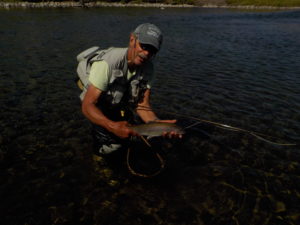
After about a half hour, it was obvious that I was not going to catch that fish with any fly I threw at it, and Bill asked if he could try for it. I said yes and after 2 or 3 casts he hooked it. After a 10-minute battle, he netted a beautiful 19-inch rainbow. After releasing the fish, he crossed the river to my side holding something. “Here”, he said, “I really appreciate you giving me a chance to catch that fish. It made my day”. Then he gave me a fly like the one he had used to catch the fish.
I was really impressed with what he did and told him that I would mention the incident it in this column for it was a fine example of stream etiquette. While talking, I could see that he was wet wading (no waders) and he wore knee pads.
Seeing that I was a novice to this type of fishing, he offered me some advice: “Approach the river with stealth and keep your profile low. Otherwise, the fish will see you because the rivers out here are crystal clear and flow fairly slow with little if any ripples to break up the line of sight”.
That explains the knee pads, for they allowed him to cast his fly while kneeling.
We didn’t exactly knock them dead that day. I only got one trout, Paul had a few big ones on but they broke him off. Allen caught a nice cutthroat measuring around 19 inches.
The second day proved to be much more successful. Some beautiful trout were caught that day with Paul having a phenomenal day catching lots of fish. Dr. Charles Wohl, a well-known, superb fly fisherman from Lenox best describes days like Paul had. “The fishing was obscene!” Paul caught his fish on tiny (size 20) blue winged olive mayflies (Baetis). I had a decent day, too, but never figured out what the trout were hitting. I caught a few on a ladybug imitation and also had some success with a gray drake mayfly (Siphlonurus). I don’t believe any of us caught a trout less than 15 inches. Bear in mind, these are wild trout, not stocked.
One day we went to see Old Faithful and while in the area we fished the Firehole River. Instead of water temperatures in the 50’s, this water was in the 70’s due to the nearby geysers. We still managed to catch a few fish there.
One rainy day when we got back to our house in Gardiner, Allen and I fished the Yellowstone River right in back. I got into an unbelievable pod of whitefish that simply would not leave me alone so that I could catch some trout. They are a scrappy fish in their own right. When they stopped rising, the rainbow trout starting rising and Allen caught a half dozen or so in short order. Craig joined us that evening and Allen and Mike cooked us up a tasty meal.
The next day, Mike and Craig took a guided float fishing trip down the Yellowstone River near Livingstone, MT. They hired Yellowstone Anglers (guides) out of Livingstone. They caught some nice fish but Mike took the big fish of the trip, a 24 inch,7 lbs brown trout. 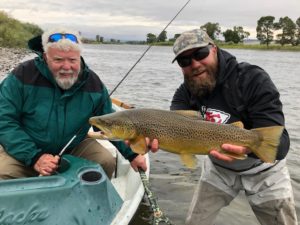 He caught it on a size 8 fly called the Night Stonefly. I don’t want to imply anything, but shortly thereafter, Craig managed to impale his fly into the back of Mike’s head, purportedly caused by the strong winds that day. Although tangled in Mike’s hair, the guide was finally able to get it out while still managing the boat as it drifted down the river.
He caught it on a size 8 fly called the Night Stonefly. I don’t want to imply anything, but shortly thereafter, Craig managed to impale his fly into the back of Mike’s head, purportedly caused by the strong winds that day. Although tangled in Mike’s hair, the guide was finally able to get it out while still managing the boat as it drifted down the river.
We were happy that Mike caught that beautiful fish for he had not yet been able to get out fishing at all this year.
On that day the remaining three of us fished Obsidian Creek, the Gardner River and the Gibbon Creek. The waters were cold with temps of 43 degrees. Too cold for hatching mayflies.
The following day, Craig and Mike fished Nelson Spring Creek (private waters on the Nelson Ranch in Livingstone, MT). They paid to fish a stretch of that water and caught some beautiful trout.
Having fished in Yellowstone National Park for around 35 years with his father, Craig knew what he was doing and when he joined us, he proceeded to clean our clocks. He caught more fish in his three days with us than we were able to catch in our 11 days, and some of them approached 20 inches.
There was one day when Craig led us on a hike across the prairie for about a mile to fish a stretch of Slough Creek. We no sooner got there when it turned windy and rainy. Fortunately, we had our rain jackets, but it sure got cold. In spite of fish jumping and porpoising, they were extremely selective. The only person to figure them out was Craig. He was using a size 22 or 24 blue wing olive mayfly, not much bigger than a speck of black pepper.
After fishing with us for three days, Craig moved on to fish the Madison River and other streams on the western end of the Park, also having great success
All in all, it was a very enjoyable trip with lots of big, beautiful trout being caught by all.
A couple of incidences did occur which could have made my trip go south quickly. The first occurred in the Minneapolis/St Paul Airport as we were heading west. While passing through security and sending my carry-on bags through the scanning machine, a security person took out my cell phone and tablet and put them into a separate tray to go through the scanner. After passing through security and about to leave the area, a passenger who followed me in line shouted that I had left those two items. Oooh! On that cell phone was my future flight and boarding pass info.
The second incident occurred when we were sitting outside on the deck on our last evening in Gardiner. Paul asked if I had gotten my boarding pass information yet. I hadn’t. While processing the information, he discovered that I wasn’t on the same flight out of Bozeman as they were and that my flight was scheduled 2 hours earlier than theirs. Because we had rented only one vehicle, it meant that everyone had to get up 2 hours earlier and leave for the airport by 7:00 am. We all had to scramble that evening to get our bags packed and ready to travel early the next morning.
If it wasn’t for Paul checking my flight information, I would have missed my flight.
Either of those two snafus could have really messed up my trip. Who knows where I could have ended up. I could have been the second man whose fate is still unlearned, and never will return, not from ‘neath the streets of Boston’, but from up in the “big sky” of Montana.
Fortunately, all ended up well. We all joined up in Minneapolis and flew to Albany on the same flight.
Questions/comments: Berkwoodsandwaters@roadrunner.com. Phone: (413) 637-1818
Beauty and good fly-fishing abound in the Yellowstone National Park
Last month, five of us local anglers went on a 11-day fly-fishing trip for trout to the Yellowstone National Park in Wyoming. Our group was made up of Paul Knauth and Craig Smith of Hinsdale, Allen Gray of Pittsfield, Attorney Michael Shepard of Dalton and me.
We flew into Bozeman, MT, rented a vehicle and drove to Gardiner, MT, where we rented a nice house on the banks of Yellowstone River (Upper Yellowstone River Retreat, Relax@yellowstoneretreat.us) just a short distance from the entrance to the Park and each day, we traveled to our fishing destinations in it. Yellowstone National Park is 63 miles north to south, and 54 miles west to east as the crow flies. It encompasses 2,219,789 acres; 3,468 square miles and is larger than the states of Rhode Island or Delaware. The park sits on the Yellowstone Plateau, at an average elevation of 8,000 feet above sea level. The plateau is bounded on nearly all sides by mountain ranges of the Middle Rocky Mountains, which range from 9,000 to 11,000 feet in elevation.
While there, we did some sight-seeing of geysers such as Old Faithful and the Mammoth Hot Springs, watched elk munching on the lawns of the park headquarters (formerly Fort Yellowstone), watched the wildlife in the Lamar Valley, and were held breathless by the beauty of the area.
We carried canisters of bear spray wherever we fished, even if we fished the Yellowstone River in back of our house, for there had been recent reports of grizzly sightings there. If you have been following this column over the years, you know that for some reason bears (black and grizzly) have some kind of attraction to Mike Shepard and me and usually cause us some form of consternation. We did a lot of looking over our shoulders while fishing in Yellowstone.
One day, I was totally focused on fishing a particular stretch on the Soda-Butte Creek where I saw that there were some nice cutthroat trout feeding. In order to get to it, I had to cross one branch of the creek, walk across a small island and then fish the branch on the other side. I was totally focused on those trout. Then I thought I heard a sound behind me. It was kind of a low inhaled snort and it sounded quite close.
When I turned around, I was startled to be face-to-face with a HUGE bull buffalo and he was looking at and walking (not rushing) straight toward me. What do you do when a 10 foot, 2,000 lb buffalo approaches you? Why step aside, of course, and that’s what I did. He just walked by me toward the river. He was so close that I could have touched him with the tip of my flyrod. As he went by, he continued that deep, soft snort and I could almost understand him saying, “Darned fly fishermen, they’re everywhere these days. Get out of my way dude so I can cross this river”.
Every day while driving back and forth to the rivers in the park, and we fished several, we saw herds of buffalos (or bison if you prefer). The Yellowstone herd size is estimated to be ovcr 5,000. More times than not some would opt to step out onto the road and just stand there or slowly poke along the center line, holding up traffic and not leaving until they were ready to. They were everywhere, especially in the Lamar Valley and lots of people were parked off of the roads observing them and other animals with their high-powered sighting scopes and cameras.
If you go there to fish, you cannot use felt-soled boots, no lead, the flies must be barbless and the fish should be released. In order to gain access to the park, you must have a pass and a permit to fish in it.
When we returned to our house at the end of each day and sat out on the back deck having a drink, elk would show up on the lawn and eat the leaves off of (and nearly destroy) a young apple tree as well as the green grass that was watered daily via a pump from the river. They showed up nearly every day, sometimes not more that 15-20 feet away from us. There was also a bull elk there keeping his group of cow elk in line.
One day, a buck antelope (pictured) appeared on the other side of Slough Creek from where we were fishing. We had all gathered there at the end of the day before our long trek back to the vehicles. He seemed agitated that we were there and jumped into the river and swam toward us. Climbing out of the creek, he was ready to do battle with us, kicking up dirt with his hoof and his head down. 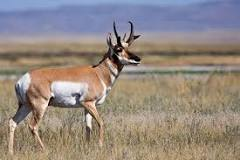 He especially wanted to do battle with Paul and starting approaching him. We told Paul to be careful as those antlers are sharp. But Paul stood his ground, threw his hat down, kicked up a little dirt of his own and shouted “C’mon, let’s see what you got!” The antelope chickened out and walked away.
He especially wanted to do battle with Paul and starting approaching him. We told Paul to be careful as those antlers are sharp. But Paul stood his ground, threw his hat down, kicked up a little dirt of his own and shouted “C’mon, let’s see what you got!” The antelope chickened out and walked away.
Yellowstone National Park is filled with all kinds of animals. In addition to the elk, buffalo and antelope, we saw a family of moose, a black wolf with its pups, golden and bald eagles, ospreys, a black bear, sand hill cranes, otters and more. Thankfully we saw no grizzlies or cougars although they do exist there. The scenery is breath-taking.
None of us are exactly spring chickens. Three of us are in our 70’s, a 65 year older and a kid aged 56. Unfortunately, I had the dubious distinction of being the oldest. Our bodies, although having been dinged over the years and sporting some replacement parts, still carried us for miles through the prairies, ever on the alert for gopher holes, to get to good looking fishing spots.
We ate well on this trip with Mike and Allen doing the cooking. After dinner, we gabbed around the dinner table, had a night cap and hit the sack. We didn’t have any television service and quite frankly, we didn’t miss the shenanigans going on in Washington these days.
The weather was unpredictable with 90-degree sunny weather one day and biting cold wind and rain the next. The fishing was just as unpredictable with some days getting skunked or only catching a couple of fish and on other days we had great catches.
So how did we do? So many people have written that fishing is not all about fishing. The most recent words that I read regarding this subject were by Cameron Pierce in the introduction to his new book, Taut Lines. “ …but as all anglers know, the fish themselves are only half of fishing. Finding peace, spirituality or a sense of belonging in nature, the meditative tranquility that settles in the mind and body as you cast into the waters for hours on end, the companionship or, alternately, the solitude; these are some of the things that hook anglers as much as fish”.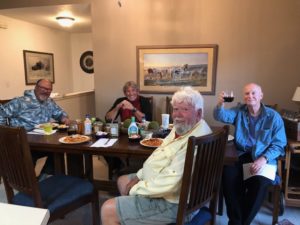
How true. Trout live in some of the most beautiful places in the world, surrounded by undisturbed, wonderful sights. Add to that the comradery of the anglers and you have the makings of a wonderful fishing trip whether you catch a fish or not. I tried to convey some of that feeling in today’s column.
Oh yes, by the way, we all caught big, lovely fish. Next week, I’ll tell you all about them.
Local trout stockings
The following local waters were scheduled to be stocked last week: Deerfield River, Littleville Reservoir, Goose Pond, Laurel Lake, Lake Buel, Onota Lake, Richmond Pond and Stockbridge Bowl.
Trout Unlimited Meeting
The Taconic Chapter Annual Meeting will be held at The Cork and Hearth Restaurant, Rt 20 Lee, MA on Thursday, October 10 at 6:00 pm. The guest speaker will be well known Fly Fisher/Fly Tier/Guide Torrey Collins. He will be discussing Great Lakes Salmon/Steelhead fishing. It is free and open to the public and if you wish, you can join them downstairs in the dining room for dinner after the event.
Let’s pay more attention to the health of our lakes
More and more attention is being paid to controlling native and invasive aquatic vegetation in our lakes these days. (Calling them weeds is out nowadays, those green plants growing in and choking our lakes are now called aquatic vegetation.) Some think that lowering our lake levels in the winter to freeze and kill them is the way to go. That is a controversial subject and others wonder if we are accomplishing anything by lowering the lake levels other than protecting people’s docks and other property.
And what about the cyanobacteria stuff that showed up in Stockbridge Bowl last year and Pontoosuc Lake this year. Where did that come from? What is causing it?
I don’t think anyone has the perfect solution for controlling excessive vegetation growth and bacteria in our lakes but we need to do something. Inaction is not an option for we could lose these beautiful bodies of open water. We need to educate ourselves and pay more attention to the health of our lakes. Here are a few opportunities:
LAPA-West Symposium
The Lakes and Ponds Association will be having a symposium on Saturday, October 5 from 9:00 am to 1:00 pm at the Zion Lutheran Church, 74 First Street in Pittsfield. There will be a significant focus on cyanobacteria (AKA blue green algae) which is a potential threat to all our lakes and can pose a serious health threat to all lake users, especially children and pets. It made the local news last fall when a bloom in Stockbridge Bowl forced the relocation of the 2018 Josh Billings paddling leg.
All lake association members, Conservation Commission members, other municipal officials and anyone else with an interest in protecting and improving our lakes are invited.
The objectives of the cyanobacteria presentations are to provide background needed for lake managers on:
• The basics of what it is and what are the risks.
• How to test for it?
• How to prevent and/or treat a bloom?
• What precautions must be taken to avoid risks to lake users without over-reacting and needlessly restricting access to our lake resources.
• What federal, state, and local agencies are involved, what regulations are in place, and how can local lake managers get help.
Other symposium topics, many of which are follow-up to previous symposium presentations, are:
• Drawdown effectiveness and risks.
• Increased State funding for our lakes and ponds.
• Improved coordination among the EOEEA regulatory agencies.
• Guidance from the DFW on maintaining and improving healthy fisheries.
Registration with a light breakfast starts at 8:15. Tours of the USEPA CMC mobile laboratory will be conducted after adjournment at 1:00 pm. (This facility is used to provide on-site trainings on the Cyanobacteria Monitoring Collaborative program to lake associations, state water quality managers and staff, drinking water suppliers, NGOs, school systems, private research entities and the like. Trainings and/or demonstrations of the program can be provided on request. The mobile lab provides a platform where individuals can participate in collecting and analyzing samples adjacent to the waterbody and become familiar with the equipment, steps, and protocols used for understanding and managing harmful cyanobacteria and blooms. The mobile lab has been used to teach hundreds of individuals throughout New England how to appropriately collect and identify samples for cyanobacteria analysis).
The symposium which is free, is sponsored by the LAPA West member associations. Invited exhibitors include state agencies with responsibilities for lake management and contractors who work on our lakes.
There will be opportunities to network with experts in lake ecology and management, and with other lake advocates. Bring lake plants you want identified. Any other questions you have specific to your lake can be raised with the experts and other attendees during the presentation breaks.
You are asked to let them know if you are planning to attend. Also please indicate whether you will be staying after the 1:00 pm adjournment to tour the CMC Mobile lab.
Lake Winter Drawdowns
An article in Volume 64, Issue 8 of Freshwater Biology which came out in June of this year and dealt with annual winter drawdowns might be of interest to local conservation commissions, lake and pond associations, anglers and the general public. The 15-page article, entitled Annual winter water level drawdowns limit shallow-water mussel densities in small lakes detailed the findings of a 2-year study (2015 and 2017) of 13 western and central Massachusetts lakes. The 9 lakes studied in the Berkshires were the following lakes: Onota Lake, Ashmere Lake, Richmond Pond, Stockbridge Bowl, Goose Pond, Greenwater Pond, Lake Garfield, Lake Buel and Otis Reservoir.
The report provides evidence that annual winter water level drawdown regimes in lakes constrain mussel distributions below drawdown exposure zones during normal water levels in addition to causing stranding and mortality soon after drawdown exposure.
In addressing the drawdown effects on mussel distribution, density and size, the report provides evidence that they negatively impact surface and buried mussel densities in areas annually exposed during winter even though these areas remain submerged from spring to autumn. Winter drawdowns also negatively affect buried mussel size.
Interestingly, the study provided evidence that mussel mortality did not correlate with drawdown rates. They found no difference in mussel mortality in experimental dewatering rates of 4 cm/day verses 8 cm/day.
The study concluded that “given that the documented ecosystem services mussel populations provide, including biofiltration, water column and sediment nutrient coupling, and habitat structure for macroinvertebrates and primary producers, the constraint of mussels deeper than the drawdown exposure zone may reduce these ecosystem services in the exposure zone. The extent of these potential functional losses relative to the whole lake ecosystems may depend on winter drawdown regime character (e.g. magnitude, rate, timing, frequency) relative to mussel population density-depth distribution and population size”.
Further research to examine the extent of potential ecosystem function loss in annual winter drawdown regime was encouraged. (Personally, I would like to see a study done to see what, if any, effects the herbicides that we are annually putting into our lakes are having on the mussels and other crustaceans).
So, why do we care about freshwater mussels? Well, according to MassWildlife, more mussels mean cleaner water. They are nature’s great living water purifiers. They feed by using siphons to filter small organic particles, such as bacteria, plankton, algae, and detritus, out of the water. This filtration doesn’t just take nutritious bits out of the water for the mussels to eat, it also takes floating debris like silt and algae out of the water, making the water cleaner for everyone.
One mussel can filter up to 15 gallons of water moving over it in a single day. We need them and should take care to see that we have healthy populations of them in our waters.
Map, Compass and Survival course
The free course will be offered by MassWildlife on Saturday, October 12 from 8:00 am to 5:00 pm at the DCR Visitor Center, 740 South Street in Pittsfield. This course is not recommended for students less than 12 years of age.
Students will spend a lot of time outside in the woods practicing map and compass skills. MassWildlife recommends wearing comfortable footwear (i.e. hiking or running shoes), long pants, long-sleeved shirts, and bright outer clothing. Students should also carry insect repellent, sunscreen, and water with them while in the woods and, if available, a whistle.
Timberdoodle time
Woodcock, (also known as timberdoodle) hunting season opens on October 3 and runs through November 23. The daily bag limit is 3 and the possession limit is 9. The woodcock is a migratory bird so hunters must register with the Harvest Information Program (HIP) each calendar year. Waterfowl stamps are not required nor is the use of non-toxic shot when hunting woodcock.
For more information on the regulations, click onto https://www.mass.gov/service-details/migratory-game-bird-hunting-regulations
Fishing, Gone?
Fishing, Gone?
Humans have a rapacious relationship with the world’s oceans, extracting immeasurable quantities of its inhabitants and resources, while simultaneously depositing unbound sums of pollution into it. That’s according to Sid Dobrin, author of Fishing, Gone? Saving the Ocean through Sportfishing. If we are to move toward sustainable practices, he writes, then we must first move toward ways of thinking about fish and fisheries beyond mere economic agendas. And there is one group in particular who could make an impact: saltwater anglers.
Recreational saltwater fishing is big business and big culture. The industry is one of the largest in the United States, but that has not translated into a cohesive effort, agenda, or ethic. Saltwater anglers, a diverse group with a range of motivations, do not belong to a single organization through which to galvanize significant voting or lobbying power toward conservation regulation. As a result, federal policymakers have traditionally focused on commercial harvesting interests.
Fishing, Gone? Is not about whether oceanic devastation, global warming and sea rise, we already know that, this book is about what is next.
Regional fisheries management have historically been dominated by commercial fishing interests and there are far more commercial fishing representatives than recreational fishing representatives on the Saltwater councils. This in spite of the fact that there are almost twice the number of jobs in some regions supported by recreational fishing than commercial fishing.
Dubbed the “most contemplative of pastimes,” recreational fishing provides a valuable perspective on how humans interact with saltwater environments. Fishing, Gone? builds on this tradition of reflection and opens up the saltwater sportfishing life as a method for thinking through the current status of marine fisheries and environment. Author Sid Dobrin calls on fellow saltwater anglers to reconsider their relationship to fishes and the ocean—the sport can no longer be only about the joy and freedom of fishing, but it must also be about living for the ocean, living with the ocean, and living through the ocean. It is about securing the opportunity to fish on while meeting the economic and environmental challenges that lie ahead.
For a while, the prevailing attitude was that ocean fisheries are inexhaustible and that nothing that we do would seriously affect the number of fish and any attempts to regulate these fisheries seems useless. If we are to move toward practices and promote ocean sustainability, then we must first move toward ways of thinking about fisheries beyond economic frames.
We understand and measure fish populations in terms of weight rather than numbers and we think about a population as a mass and not a collection of individual organisms. We don’t count populations of terrestrial game in weight but numbers. We refer to wild animals as “wildlife”, unless they inhabit the marine environment in which case we refer to such animals as simply seafood.
Most Americans have no idea that the fish they eat, which are harvested from waters they collectively own, have been deemed the private property of a few sea lords who sell those citizens own property back to them in frozen filets.
The recreation angler might be tempted to dismiss the catch-share fight by believing it is a problem for the commercial part of the allocation; we still have our recreational allocation. However, as catch-share owners gain stronger foothold with the NOAA councils, we see allocations leaning more heavily toward the commercial side of things.
In his book, Dobrin calls for a new ethic for saltwater anglers. This new ethic is necessary if recreational anglers, saltwater and freshwater, are to contribute to the protection of our communal waters and deeply treasured pastime. Some of the items of his manifesto are:
Saltwater recreational fishing is not a right but a privilege (an economic privilege) and with that privilege comes a responsibility, that to lend a communal angler voice to policy making.
Contemporary anglers’ ethic requires the accounting for the 3 primary facets of recreational fishing (a) the actions of the angler (b) the effects on the fish and (c) the impact on local and global ecosystems.
All anglers must adhere to the strictest care and empathy in harvest methods, only fish harvested are those to be eaten, used as bait to catch other fish or those to be used for scientific research. A catch and release mentality should be imbued.
We must think about fish and fisheries beyond economic frames. This includes understanding the role of every organism in local and global ecosystems. There is no such thing as trash fish.
The individual angler’s minimal harvest is compounded across the recreational angler population and can have a noticeable effect not just on fishery populations but on every aspect of human engagement with the ocean.
Lastly, Dobrin writes that fish populations are necessary in the global protein economy. Recreational anglers must support technological development of methods such as mariculture as an alternative to wild harvest while simultaneously finding a balance for the management of wild harvest that accounts for recreational needs and a reduced and monitored commercial harvest. All such ethics will inevitably be bound up in complex management policies as well as deep-seated philosophies of what it means to be a recreational saltwater angler.
In my opinion, this is a deep book (pardon the pun) and not one to have on your bed stand. It is well written with sufficient supporting data for Dobrin’s position and the reader must slow it down and absorb. He makes compelling arguments for his positions based upon sound data. I’m not sure the world is ready to implement his recommendations, but his data is difficult to refute. This book is an eye opener, perhaps ahead of its time and I suspect people will be talking about and referring to it for years to come. It may very well become required reading for ecology students.
If you are a serious salt water angler, you might want to pick up a copy.
The 263-page softcover book is priced at $30 and published by the Texas A&M University Press.
Congratulations Jr Campers
MassWildlife reports that over 100 kids aged 13 to 17, graduated on August 17 from the Massachusetts Junior Conservation Camp. A couple of them were from our area. They learned about outdoor skills like fishing, hunting, camping, archery, & firearm safety. They also learn forestry, soil conservation, aquatics, and wildlife management.
This is an excellent program. If you have a young outdoorsperson coming up the ranks, you might want to consider sending him/her to next year’s camp. For more information on that program click onto https://www.mass.gov/service-details/junior-conservation-camp.
Life Preservers
Don’t forget! From September 15 to May 15 Massachusetts regulations require that anyone using a canoe or kayak must wear a life preserver. Don’t sit on it, wear it!
Home from another fishing trip
I have been away on a flyfishing trip to the Yellowstone area of Montana and Wyoming with several local flyfishing buddies. By the time you read this column, I should have just gotten home earlier this morning (Good Lord willing). Last week’s and today’s columns were written prior to my leaving.
I am not sure what transpired around here during the period that I was away, so next week I will try to catch up on the news before writing about our trip. Hopefully we weren’t harassed by any black or grizzly bears, trampled down by buffalos, or dragged down an airplane aisle screaming and shouting.


